"To Be Treated Like Normal Human Beings"
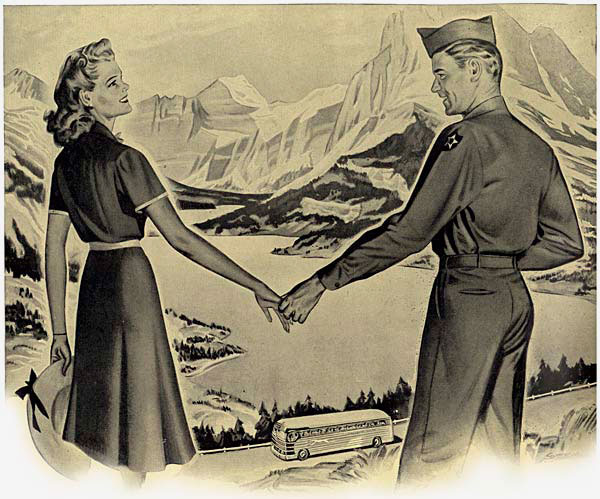 Romantic visions of reuniting with returning veterans filled advertisements in the waning days of the war and into the postwar period. Shown above is a Greyhound Bus advertisement. (Folder 19, Box 37, Defense Council Records, OSA)
Enlarge image
Romantic visions of reuniting with returning veterans filled advertisements in the waning days of the war and into the postwar period. Shown above is a Greyhound Bus advertisement. (Folder 19, Box 37, Defense Council Records, OSA)
Enlarge image Nearly 150,000 Oregonians served in the military during World War II and over 3,700 died as a result. Men from each of Oregon's 36 counties served. They came from the remote ranches of Harney County dozens of miles from any paved road, from the densely packed apartments of central Portland and everywhere in between. From every corner of the state, from every walk of life, men and women answered the call to service and discharged their duties honorably. Along with those families that grieved sons and fathers and brothers who made the "supreme sacrifice," many others coped with disabilities, both physical and mental, wrought by war. Meanwhile, most returning veterans wanted to get on with their lives: marry their sweethearts, buy homes, have children, and live the "American Dream" they had deferred for so long.
Demobilization Churns Forward
The demobilization of about 12 million men and women serving in the U.S. armed forces at the close of the war was destined to be a drawn out affair for practical and strategic reasons. Simply moving that many people quickly from the far corners of the globe would be impossible. But the real reason was that the world remained a dangerous place in the wake of the war as power vacuums developed around the world with the collapse of the Axis powers. Soviet dictator Joseph Stalin began executing his designs on eastern Europe. Communist forces were on the march in China and elsewhere. Dozens of colonies held by Britain, France, Belgium, and other powers posed control problems as calls for independence grew louder. Many American servicemen were destined to serve long duty as part of large occupation forces in Germany and Japan. While new inductees would eventually be sent to replace them, it was not be fast enough for many anxious men ready to go home. Most veterans were allowed to return to civilian life but the process for many, depending on their duty and location, was agonizingly slow.
Footnote
1
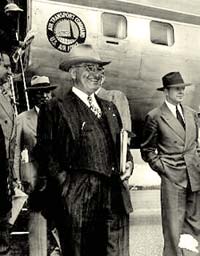 President Truman at the Salem Airport in 1948. He oversaw the demobilization of millions of veterans after the war. (Image no. MJON0070, courtesy Salem Public Library, Marion County Historical Society Photographs)
President Truman at the Salem Airport in 1948. He oversaw the demobilization of millions of veterans after the war. (Image no. MJON0070, courtesy Salem Public Library, Marion County Historical Society Photographs) Just as President Truman was officially announcing the surrender of Japan in August 1945, he was also making demobilization plans, forecasting that over five million men would return to civilian life in the next 12 to 18 months. He ordered the immediate reduction in selective service inductions from 80,000 to 50,000 per month. And he ordered the local draft boards to stop inducting anyone over 25 years old. Oregon's demobilization experience mirrored national events. By March 1, 1947, 118,292 Oregon men and women had returned to civilian life, leaving just under 30,000 in the service. Some of those still serving had chosen military service as a life vocation despite being eligible for discharge. Many servicemen, because of disabilities and other reasons, were discharged long before the end of hostilities.
Footnote
2 Uneven Changes Brought by War
Demobilized veterans returning to Oregon experienced vastly different circumstances during the war, depending on where they went and what they did. Some spent the entire war in a relatively routine and uneventful environment not greatly removed from their civilian experience--the 28-year-old civilian auto parts clerk who entered the Army and became a supply clerk at a base in California for most of the war. Conversely, others were thrown into a maelstrom of death and brutality--the 18-year-old farm boy who entered the Marines and survived the bloodbath at Iwo Jima, killing the enemy in hand-to-hand combat, stepping over rotting bodies, and watching his friends die.
Likewise, the communities they returned to experienced the war in different ways as well. Some communities, far away from defense industries or military bases, changed little. They may have stagnated and lost some of their population to migration during the war, but they were essentially the same. Others, such as Hermiston and Medford, had been transformed by defense activity. Their populations boomed with many "outsiders" moving in and changing the culture. While their downtown core was recognizable, new businesses and slapdash housing had been built to cater to the boom. Many of the faces a returning veteran saw walking down Main Street would not be familiar. Thus, the range of reactions varied greatly from veteran to veteran and community to community. This was complicated further by the size and strength of a person's family and social network before and during the war. Those with strong family ties, close friends, and deep connections to churches, clubs, and similar organizations were less likely to suffer problems during their "reabsorption" into civilian life.
Veterans' Expectations
Even before being discharged, many servicemen had specific opinions about returning to civilian life. Jobs were high on the list of priorities, according to W.M. Kipplinger, who compiled quotations of their expectations and fears from hundreds of letters in June 1945. One serviceman wrote, "you can't take twelve million men, and train them in a new life, and churn them all up, and then expect them to go back to the same old ruts." Others were frustrated that they would be late for the "postwar scramble" for jobs. They heard many civilian war industry workers had already quit their defense jobs "to bed down in more permanent peacetime jobs, and the men think this is 'lousy rotten.'" One man said, "I think the country owes me a better job than I had, but I don't think I'll find it if I am not discharged ahead of the mob." Few men wanted to make a career of the military, saying instead that they "already have a bellyful."
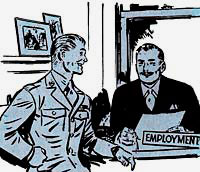 Jobs were a high priority for returning veterans. (Folder 13, Box 36, Defense Council Records, OSA)
Jobs were a high priority for returning veterans. (Folder 13, Box 36, Defense Council Records, OSA) Many correspondents were tired of foreign lands and people, with one confessing, "for the first time in my life I appreciate my home town." Others were fed up with military rules and regulations and were concerned about more of the same upon returning to civilian life: "I don't want government regulating everything when I get back." Some servicemen resented the frivolous civilian "high life" shown in magazines. One man grumbled that "Jitterbugs [people enjoying a lively style of dancing] and other silly people ought to have to come out here and see what we have seen and it would cure them."
Footnote
3 Home Front Expectations
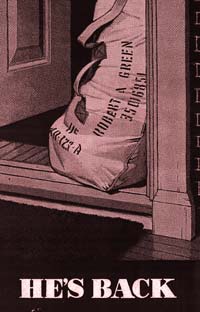 Many friends and family were apprehensive about how to act around returning veterans. (Folder 4, Box 35, Defense Council Records, OSA) Home front civilians had their own opinions and apprehensions about how to welcome and relate to returning loved ones and friends. There was no shortage of experts offering advice on the subject in the months before and after the Japanese surrender. But many returning veterans had advice of their own, saying people should "stop trying to practice amateur psychiatry on them, don't be misguided by the widely published attempts to tell you 'how to handle' these 'changed men.' Instead, welcome the boys home naturally, as what they are--that is, fundamentally the same boys who went away." The men complained about the "patronizing, over-sympathetic, kid glove treatment" and were disgusted by "the impression created among the home folks that most returned soldiers were strange neurotics who didn't want to talk about what they'd been through." One returning Army sergeant recounted his frustrating homecoming: "Ma kept watching me all the time, trying 'not to do anything that would make me nervous.' Of course that just made me nervous as hell."Footnote
4
Many friends and family were apprehensive about how to act around returning veterans. (Folder 4, Box 35, Defense Council Records, OSA) Home front civilians had their own opinions and apprehensions about how to welcome and relate to returning loved ones and friends. There was no shortage of experts offering advice on the subject in the months before and after the Japanese surrender. But many returning veterans had advice of their own, saying people should "stop trying to practice amateur psychiatry on them, don't be misguided by the widely published attempts to tell you 'how to handle' these 'changed men.' Instead, welcome the boys home naturally, as what they are--that is, fundamentally the same boys who went away." The men complained about the "patronizing, over-sympathetic, kid glove treatment" and were disgusted by "the impression created among the home folks that most returned soldiers were strange neurotics who didn't want to talk about what they'd been through." One returning Army sergeant recounted his frustrating homecoming: "Ma kept watching me all the time, trying 'not to do anything that would make me nervous.' Of course that just made me nervous as hell."Footnote
4
Many returning veterans emphasized that each person needed to be treated with common sense as an individual, not as a potential "problem child" experiencing a "painful readjustment" to civilian life as advocated by many of the "When-He-Comes-Home" articles. A Marine officer, back from duty in the South Pacific, summed up his opinion: "The whole thing is wrong--trying to set up rules on how to treat men back from war. There are no rules. Every man is different. People draw up plans about just how they are going to act when Johnnie comes through the front door. Then Johnny comes in the back door, and they're all upset." A lack of common sense in much of the advice troubled some veterans. For example, some articles cautioned family and friends to avoid questions about combat experiences. One observer scoffed at the notion. While allowing that no man wanted to be prodded into talking about the subject, "the normal service man wants to talk. Why not? They are the most exciting, the most terrible, the most important things that have ever happened to him in his life, or probably ever will. What else would he talk about?"
Footnote
5
Most informed observers recognized the majority of returning servicemen would not suffer a "painful readjustment." Major General Norman T. Kirk, Surgeon General of the Army, counseled that the average returning soldier was "basically the same man he was when he went away." Kirk argued that the military discipline and experiences far from home had matured the average soldier so that "the large majority of these men can take their experiences in stride and can return to their homes, their families, and their jobs finer citizens, ready and able to shoulder their share of responsibility in the civilian world." Others claimed that the challenges endured by the returning veterans made them uniquely qualified as leaders in the community. Because of the wide range of circumstances involved, most of those giving advice were right--at least part of the time. In fact, most veterans adjusted to civilian life without significant problems, applying the self-confidence and "can-do" attitude gained from years of overcoming obstacles and learning new skills. Sadly, some veterans fell victim to what is now called posttraumatic stress syndrome, which when left untreated was destined to lead to despair and tragedy for many families after the war.
Footnote
6 Disabled Veterans
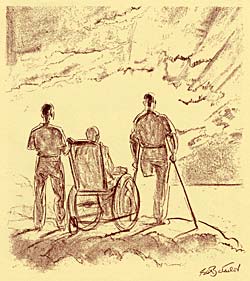 Many veterans returned to civilian life with disabilities. Governments offered services but pushed disabled veterans to be self-reliant. (Folder 8, Box 1, Governor Snell Records, OSA)
Many veterans returned to civilian life with disabilities. Governments offered services but pushed disabled veterans to be self-reliant. (Folder 8, Box 1, Governor Snell Records, OSA) Disabled veterans, depending on the nature and degree of their injuries, had additional challenges upon returning to their communities. Throughout the war and into the postwar period, a steady stream of disabled servicemen returned home after convalescence and rehabilitation. Early on, the military, Veterans Administration (VA), state and local governments, and groups such as the Red Cross, American Legion, and Veterans of Foreign Wars developed services. For instance, the Army surgeon general published information in 1944 designed for family members of disabled veterans to help smooth the return to civilian life. In one such handbook, the surgeon general lauded medical advances such as blood plasma, penicillin, improved battlefield evacuation, and the treatment in Army hospitals, but put much of the rehabilitation burden on the shoulders of the veterans' families.
Footnote
7
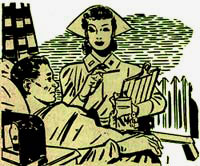 Veterans Administration hospitals helped disabled veterans adjust to civilian life. (Folder 13, Box 36, Defense Council Records, OSA)
Veterans Administration hospitals helped disabled veterans adjust to civilian life. (Folder 13, Box 36, Defense Council Records, OSA) An early challenge for many families, according to the surgeon general, centered on understanding problems related to disabilities. He noted that "at the outset, emotional upsets and black despondency are to be expected, though some men accept their misfortunes with remarkable calm and fortitude." The surgeon general pointed out that disabilities created an "unconscious dependence" on others. He argued that "gains in self-reliance made in the hospital may be swept away by the fear of pity and by resentment toward a 'make-it-easy-for-the-boy' attitude on the part of people at home." Resentments toward the Army by disabled veterans were common, with bitterness toward the men who got the "safe jobs" and toward the system that put him in the foxhole risking his life, eating canned rations, and "enduring countless hardships which other soldiers are spared." Some disabled veterans resented civilians, especially those who avoided military service because of occupational or physical deferments. Many soldiers suffered from an overly-idealized view of their prior lives. They nurtured a sort of "dream image" of loved ones, mother's cooking, and home town life that could not be sustained in reality: "All too frequently, a man comes home to find the town has gone to seed; home a bit shabby; mother's 'corn pone and fatback' not so tasty.... Maybe some 4-F [a man designated not fit for the draft] married his best girl, or his wife seems silly and superficial...."
Footnote
8
"The wife's immediate reaction was worth months of rehabilitation for she reassured her tortured husband with the remark, 'I married a man, not a face.'"
The surgeon general had plenty of suggestions for family members to help the disabled veteran with emotional problems. His first pieces of advice were to avoid treating the man "either like a hero or a martyr" and, by all means" don't patronize or pity or fuss over him." Loved ones needed to acknowledge the disabilities in order to move forward with full rehabilitation. The surgeon general told the story of a soldier recovering in an Army hospital whose nose had been shot off in battle. He wore a plastic nose temporarily until surgeons could build a new one. When his wife first came in the room and they embraced, the man's nose was dislodged and fell to the floor. According to the surgeon general: "The wife's immediate reaction was worth months of rehabilitation for she reassured her tortured husband with the remark, 'I married a man, not a face.'"
Footnote
9
Key advice focused on helping disabled veterans achieve independence and self-reliance. No matter how good the medical or technological help, the final question of success fell to the veteran and his family. Thus, "a man may be fitted with an artificial leg and shown how to use it, but it is up to the man to work at the job of developing power, balance, and skill." Family members were urged to give encouragement but to "avoid doing things for the handicapped. Adversity may become an asset with reassurance, guidance, and a chance to work things out for one's self." Disabled veterans were advised to get to work quickly since "idleness and boredom...breeds restlessness and discontent." The Veterans Administration took the lead in providing many of the services available for disabled veterans. The regional office in Portland prescribed and financed education, training and other aids needed for their vocational rehabilitation. The agency also paid compensation and pensions to disabled veterans and dependents of veterans who died in the war. Moreover, the agency operated hospitals in Portland and Roseburg for ongoing medical services.
Footnote
10 Living Memorials Proposed
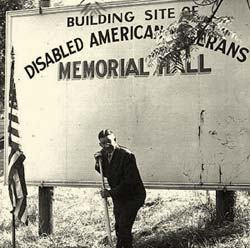 Gov. Douglas McKay breaks ground for a new Disabled American Veterans Memorial Hall in Salem in 1948. After dissension among promoters and funding problems, the hall was never built. (Image no. 9082, courtesy Salem Public Library, Ben Maxwell Collection)
Gov. Douglas McKay breaks ground for a new Disabled American Veterans Memorial Hall in Salem in 1948. After dissension among promoters and funding problems, the hall was never built. (Image no. 9082, courtesy Salem Public Library, Ben Maxwell Collection) Well before the end of the war, groups nationwide began planning projects designed to honor the veterans of World War II. One popular idea centered on the concept of "living memorials," which would not only be "symbolic of their deep gratitude but will serve some useful purpose in the community life." This was in contrast with the statues, plaques, and obelisks common to previous wars such as World War I. One leading group, the American Commission for Living War Memorials, had the motto: "Memorials that live will help build a stronger, healthier nation." This theme was underscored by the commission's direct cooperation with the Federal Committee on Physical Fitness. By January 1945 the commission counted over 400 communities across the country that were "actively engaged" in planning memorials. Governor Snell appointed a statewide committee to study and coordinate plans in Oregon. Preliminary suggestions included swimming pools, playgrounds, tennis and basketball courts, and summer camps for boys and girls organizations.
Footnote
11
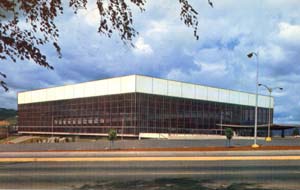 Voters approved bonds to fund construction of Portland's Memorial Coliseum in 1954. The building was completed 6 years later. (Image courtesy ballparks.com)
Voters approved bonds to fund construction of Portland's Memorial Coliseum in 1954. The building was completed 6 years later. (Image courtesy ballparks.com)
Over time the Oregon committee saw plans and proposals for projects around the state. Local organizers sought the endorsement of the state committee as a way of encouraging funding from local governments and businesses. While the committee approved most proposals it saw, it did decline some. For example, plans submitted by the Oregon Museum Foundation were not approved because they were "not in keeping with the physical fitness" theme of the program. Among the dozens of projects planned were two in the Salem area. One proposed to erect a stadium on a 100 acre site in Salem "known as Bush's pasture." The other sought to create a one-mile waterfront park along the Willamette River in West Salem. La Grande also had big plans. Organizers raised $27,000 toward a new swimming pool and were exploring the possibility of a boat landing and a golf course. While Portland didn't have any definite plans as of September 1945, the committee heard a report that "there is talk of a coliseum to hold major indoor events such as large conventions, fights, wrestling, ice hockey, automobile shows, banquets for 5000 persons, and with a seating capacity for at least 15,000 people." While it would be some time before completion, Portland eventually saw the construction of Memorial Coliseum. Many other cities moved forward with plans in the ensuing years. Some projects were never completed due to lack of funding or the waning interest of organizers. Still, many others were finished and continue to serve local communities throughout Oregon.
Footnote
12 Related Documents
Notes